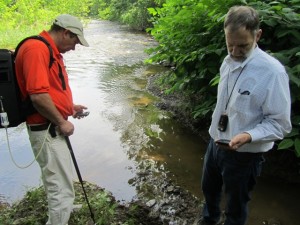Sign this Petition to Demand that Governor Cuomo Insist on a Real Environmental Review
July 4, 2012Municipal Water Supply Administrators Want MORE Regulation of Hydraulic Fracturing
July 8, 2012Independent Study Finds Significant Fault Line Methane Leaks Near PA Natural Gas Operations

CLICK HERE for the Clean Air Council press release
CLICK HERE for the field report
In the wake of recent news about Shell’s potential methane migration event in Tioga County and multiple reports of gas bubbles, methane-contaminated water, and a mud volcano in Bradford County, area residents and an environmental group are concerned.
Initial reports suggested that there may have been a substantial loss of control of natural gas from one or more of the shale gas wells in the area, including those on the Chesapeake-owned Morse well pad, which has two wells and is over a mile from the properties with affected water wells. While the Pennsylvania Department of Environmental Protection (PA DEP) and Chesapeake monitored the Bradford County sites, they have not yet released this data to the public. In response to residents’ requests for third-party independent testing, Clean Air Council, a PA clean air group, commissioned Gas Safety Inc. to monitor for potential methane leakages associated with the gas bubbling in Leroy Township.
“We’re concerned about the possibility that fracking is causing increased methane leakage from natural fault lines that previously emitted methane in much smaller amounts,” Clean Air Council Executive Director Joseph Otis Minott said.
While studies have estimated the amount of methane that is leaked or vented from natural gas equipment, Gas Safety claims that there is little to no data on how much is being emitted every day through naturally occurring fault lines that may have been altered by fracking.
“Two methane plumes were detected,” said Dr. Bryce Payne, environmental scientist and author of the report. “One larger plume substantially increased in size over a few hours, which suggests large amounts of methane were being emitted into the air. A smaller plume was also detected about 2 miles west of the larger one. The data and observations suggest natural gas has spread through an extensive underground area beyond where the plumes were found.”
“The International Energy Agency recently recommended in their Golden Rules for a Golden Age of Gas Report that drilling companies need to carefully survey the geology of the region to avoid fault lines,” said Payne. “With the already-fractured geology of Pennsylvania and parts of New York, our methane measurements demonstrate that this may prove impossible to do.”
“There are some places that you just shouldn’t drill. Scientists must continue collecting data to answer whether or not the Marcellus Shale can be responsibly drilled or even meet minimal compliance with the IEA’s recommendations.”
While no isotopic testing has confirmed the methane source, the report points out that the sustained and elevated levels of methane were indicative of a fugitive source of upwind methane. The report also states that bubbling gas in Towanda Creek was consistent with how fugitive gas from shale wells would travel through faults, fractures, and groundwater aquifers. Researchers also found high methane levels on the banks of the Towanda Creek and nearby residential water wells that were heavily contaminated with methane.
The results from this monitoring effort may shed light on the broader debate about the natural gas industry’s potential impact on climate change and even potential regional impacts on public health.
“Area residents and the Council are concerned about the potential health impacts from ground-level ozone, which is created when large quantities of methane mix in the air with other pollutants. Methane is also 21 times more potent a greenhouse gas than carbon dioxide, and the natural gas industry is the largest human-made source of global emissions. This could have a very fast and powerful impact on warming our planet,” Clean Air Council Outreach Coordinator Matt Walker said.
The Gas Safety report stated that the methane levels found in residents’ water were high enough to pose asphyxiation hazards if the water was used for showering or other high water uses in close quarters. Residents reported experiencing symptoms associated with asphyxiation.
Sherry Vargson, a Granville Summit resident, said “It makes me anxious because I don’t believe most of us know how to handle air issues. It’s not like you can put a filter on the air you breathe outside. Considering it’s a hazard, we should be made aware of what precautions we should take. I’d love to hear an answer.”
The Council shared the sampling data with the north-central regional offices of PA DEP, as well as PA DEP Secretary Michael Krancer, the Environmental Protection Agency, Region 3, and the Agency for Toxic Substances and Disease Registry, Region 3.
Gas Safety used a portable instrument built around a Cavity Ring-Down Spectrometry unit to measure methane. The device generates a high quantity of highly reliable methane measurements on a continuous basis.



